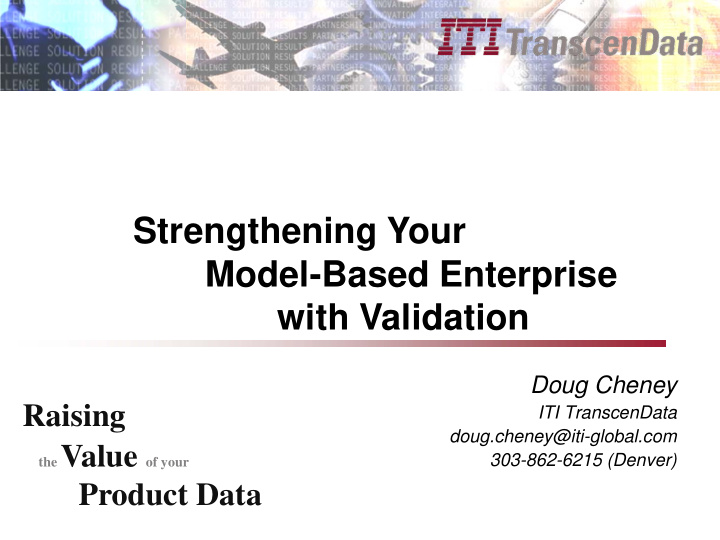



Strengthening Your Model-Based Enterprise with Validation Doug Cheney Raising ITI TranscenData doug.cheney@iti-global.com the Value of your 303-862-6215 (Denver) Product Data
Introductions � ITI TranscenData � Private, debt-free, profitable U.S. company since 1983 � International TechneGroup Inc. interoperability business unit � “Transcend above your data problems” “Smooth interoperability is a transcendental experience” � Doug Cheney � US and European upbringing � Mechanical engineering education � CAD application development � CAD model quality, CAE optimization, assembly tolerancing � Engineering process consulting � CAD to CAD/CAM/CAE interoperability � International consortia team member � ISO, PDES, ProSTEP (LOTAR), OMG, SASIG (AIAG/VDA/JAMA) MBE Model Validation Slide 2
Model-Based Enterprise � Scope � Model-Based Engineering � Model-Based Manufacturing � Model-Based Sustainability � Objectives include: � The model is the master (minimize use of drawings) � Integrate all phases of the product lifecycle � Product Model-Based Design (MBD) Model � Structure � Geometry � Annotations (aka 3D PMI, GD&T, FT&A, …) � Model attributes � Domain-specific data MBE Model Validation Slide 3
Why MBE Model Validation? � If “The model is the master”… …Then downstream modifications must be reconciled with the product design model. � If “Integrate all phases of the product lifecycle”… …Then the design model must be reusable in simulation, manufacturing, support, etc. MBE Model Validation Slide 4
The Need for Simulation Validation Design Simulation Clean-up and Rev A Simplification Differences? Manual Manual Changes? change change Differences? Rev B Unacceptable differences and unsynchronized changes undermine MBE integration of design and simulation MBE Model Validation Slide 5
Design Change Validation Rev A ?! Rev B CAE / CAM Previous Revision New Revision Clearly communicate geometry and feature parameter changes to downstream users MBE Model Validation Slide 6
The Need for Manufacturing Validation Engineering Manufacturing Defects? Defects? M B E Translation Equivalent? System A System B Extended Enterprise Defects and translation differences undermine MBE integration of engineering and manufacturing MBE Model Validation Slide 7
Model Validation Categories Master Model Derivative Model Structure Loss Completeness Degradation Accuracy Confusion Complexity Deviation Realism MBE Model Validation Slide 8
Design for Manufacturing Validation ! CAD CAE / CAM Design Model This blend has a sharp offset that is not design intent. MBE Model Validation Slide 9
Design Translation Validation CAD B CAD C STEP CAD D CAD A Design Model Minor topology change Major quality Major shape change change Not a Solid MBE Model Validation Slide 10
Advantages of Automated Validation � Technical � Comprehensive � Consistent � Repeatable � Precise � Business � Lower cost (after initial investment) � Transferable to extended enterprise � Supports process quality improvement � Human � Not dependent on human initiative (or lack thereof) � Avoid employee burnout MBE Model Validation Slide 11
Ideal Validation Software Architecture Advantages Consistent functionality User Interface No data conversion Native system evaluators Diagnostic Algorithms Access to full data model Multi-CAD Programming Interface Rapid upgrades System API A System API B Disadvantages System installation and System A System B licensing prerequisites Model Model Powered by: A A MBE Model Validation Slide 12
The Need for Legacy Migration Validation Design Engineering Manufacturing Defects? Defects? Equivalent? Changes? Equivalent? _______________ Legacy Migration Differences? _________ Simulation Unacceptable differences introduced during migration undermine MBE reuse of legacy data. MBE Model Validation Slide 13
Legacy Migration Validation ? CAD A CAD B Legacy Model Migrated Model Half of this model was lost after migrating the feature definition. MBE Model Validation Slide 14
Legacy Migration Process Evaluation Which process? Current CAD Legacy Model STEP Translation Minor changes but no features Feature Translation Manual Remastering Major changes Unintentional changes MBE Model Validation Slide 15
Product Lifecycle Transition Validation Design Engineering Manufacturing Support Defects? Defects? Equivalent? Changes? Changes? Equivalent? _______________ Legacy Migration Differences? _________ Simulation Equivalent? Self-validating? _______ MBE processes are undermined if the model is not Archival validated at critical transitions in the product lifecycle. MBE Model Validation Slide 16
Engineering Change Validation Released Model Engineering Change The change to this opening in the model is subtle and complex. MBE Model Validation Slide 17
Part Model Archival Validation ! Archival Future Present 10 – 100 years CAD CAD Design Model STEP Model Revolved faces were lost during STEP export. MBE Model Validation Slide 18
Assembly Model Archival Validation Design Model Assembly after STEP Assembly export and re-import The highlighted part’s position within the assembly changed significantly. MBE Model Validation Slide 19
Self-Validating STEP Models Native CAD Model STEP Model ISO PDQ Quality Metrics Part 59 2008 CAX-IF Sampling Points Cloud of Points (CoPs) 2006 Geometric Validation CAX-IF Mass Properties Properties (GVP) 1998 ISO Product Part 42 1995 Shape MBE Model Validation Slide 20
STEP Cloud of Points Example Design Model STEP Model Sampling points evaluated on the native model were added to the STEP model to enable precise validation after retrieval into a future system. MBE Model Validation Slide 21
The Next Frontiers… � Product Manufacturing Information (PMI) � 3D geometric dimensions and tolerances (GD&T) � Annotations (notes) � Domain-Specific Models � Composites � Electrical harnesses � Dissimilar Models � Wireframe (legacy) data � Collaboration (graphics) data � Inspection (CMM) data � Reverse engineering (point cloud) data MBE Model Validation Slide 22
Raising the Value of your Product Data via integration and interoperability solutions www.transcendata.com
Recommend
More recommend